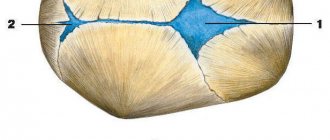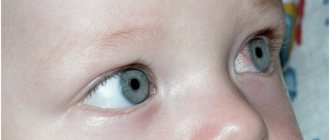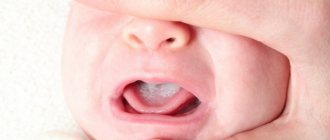What does increased tone in a child mean? Is massage effective? And what other methods of treating hypertension exist, we’ll talk below.
To talk about increased tone in a child as a disease, you first need to understand what hypertonicity is and at what age it is a problem and at what age it is normal. Increased muscle tension, expressed in their overstrain, is hypertonicity. If we look at the statistics, 90% of children have increased muscle tone. This condition is quite normal for a child in the womb. In the position inside the uterus, the baby is in a compressed state, where the arms and legs are bent and pressed tightly against the body. Once born, the baby gains freedom of movement, so the baby’s muscle tone should return to normal.
Age characteristics
This condition does not go away immediately, gradually, and as the baby grows and acquires certain motor skills, hypertonicity disappears.
Hypertonicity in a baby in the first month of life is most pronounced, which is clearly manifested in the general “tight state” of the child. The fists are clenched, the legs are pressed to the body, if you try to spread the legs, the baby will resist. In the supine position, the baby presses his arms to himself and lies in a position very similar to the fetal position. The folds on the legs should be symmetrical and, if you bring the legs together, form a smile. If, while lying on his stomach, the baby turns his head left and right, and seems to be trying to crawl with his legs, this is not a pathology and indicates normal development and moderate muscle tone of the baby. If, under the age of one month, a child often holds his head, this is most likely not a sign of his uniqueness and rapid development, but an overstrain of the neck muscles. Massage is effective for treating hypertension in a 1-month-old child.
A three-month-old child who confidently holds his head is characterized by the absence of hypertonicity. A baby at this age already reacts to toys, reaches out to them, and is able to grasp and hold objects in his hand. However, if some signs of increased muscle tone persist, do not be alarmed; each child is individual and you should wait a little and observe.
Increased muscle tone in a child should disappear by 6 months; if this does not happen at this age, you should see a specialist. A six-month-old baby is no longer the same incompetent as before; his movements are more conscious and purposeful. The fists unclench, the baby tries to crawl, rolls over on his back and from back to stomach, sits or tries to sit.
At nine months the baby is especially active, he stands near a support, crawls, and sits down. If a baby has hypertension at this age, massage is especially effective in eliminating it, since the main goal of massage is to relieve muscle tone.
The one-year-old baby is already trying to take his first steps. If hypertonicity is diagnosed in a child at this age, treatment in the form of massage and baths remains the same; if positive dynamics are not observed by one and a half years, additional diagnostics are prescribed and the treatment method is revised. By the age of three, hypertonicity can manifest itself in walking not on the feet, but on tiptoes (in the case of increased tone of the legs) and impaired fine motor skills of the hands (in the case of increased tone of the hands).
By the age of five, increased muscle tone can become a real problem. A child of preschool age begins to lag behind his peers in development, in some cases this may become the basis for establishing a disability. Studying at school with peers becomes difficult and often these children have to study in special educational institutions.
Thus, early detection of muscle hypertonicity allows you to effectively select health measures and eliminate increased tone. Therefore, it is especially important to pay attention to the symptoms of hypertension in a timely manner, which significantly increases the chances of recovery.
What if it’s not the norm?
Ideally, a neurologist should examine the baby in the maternity hospital in order to identify incipient abnormalities in time. However, the presence of physiological hypertonicity sometimes complicates the early diagnosis of many nervous diseases. Physiological hypertonicity should be considered up to 4-6 months; if the tone persists longer, this is a reason to contact a specialist - a pediatrician or neurologist.
But how to determine the tone? To do this, the doctor examines the child and checks his reflexes, because muscle tone characterizes not only the functioning of the nervous system, but also the general development of the child, both physical and mental. However, some serious violations, without going into details, can be identified in time by parents.
Today there are not many healthy mothers and babies. Violations of tone in a baby are affected by the course of pregnancy, placental insufficiency, stress and medication, the course of labor, benefits and stimulation of labor, cesarean section and the postpartum period. In addition, the nervous system and its various parts are actively developing after birth, so the baby needs to be carefully monitored, noting the time of formation of his basic skills.
If muscle tone disorders are not recognized in time, the child will begin to lag behind in physical, and therefore naturally in mental development, since his motor skills are closely related to the development of the cortex.
I offer a small diagnostic algorithm, based on which parents can notice violations in a timely manner and consult a doctor. Conventionally, in the first year there are five age intervals in which the baby must master certain skills; if he deviates from the given values, it would not be superfluous to consult a neurologist.
Period 0-1 , is studied from birth to one month, with the baby positioned on his back with his arms pressed to his chest, arms bent, hands clenched into a fist, and thumbs hidden inside the fist. The legs are spread and bent at the knees, the left and right halves of the body are symmetrical, the head is positioned evenly, without deviating to the sides.
If you turn the baby on his stomach, he will turn his head to the side, placing his arms under his chest and bending his legs, imitating crawling movements. By the end of the month, the baby tries to lift and hold his head for a few seconds, placing it parallel to the line of the spine.
Period 1-3 , studied from one month to three months. When positioned on the back, the flexion of the arms is less pronounced than in the first period, but is still preserved. The baby can push them forward and move them to the sides, and can bring their hands to their eyes or mouth. closer to three months, he tries to reach for the toy, and when he puts it in his hand, he holds it tightly. The child tries to lift and hold his head. By turning it towards a source of sound or light. When pulling by the arms, he tries to pull himself towards the adult’s arms, holds his head, especially confidently by the end of the third month. In parallel with pulling up, flexion in the legs is observed.
When the baby is placed on his stomach, the baby lifts his head, holds it in this position for a long time, and actively turns his head in different directions. When raising the head, support is placed on the forearms, and the arms are slightly extended at the elbows. The legs perform crawling movements, bending at the hip and knee joints.
Period 3-6 months . Lying on his back, the baby opens his palms, arms and legs are bent. The baby can put his hands together, making “palms”, bring it to his mouth, feel the diaper, the toy, the parents, finger it, purposefully reach for the toy and grab it. If in the initial period he can grab objects in front of his chest, then by the end of the period he can also grab objects on the side of himself or in front of his face. The child groups his limbs, making his first attempts to sit up. When pulling by the arms, by the fifth month the baby holds his head and body in the same plane, his legs bend slightly. By six months, the chin is brought to the chest, and the legs are bent and pressed towards the stomach. When positioned on the stomach, the child confidently holds his head, positioning it exactly along the line of the spine, confidently resting on his forearms, and his palms are open. By six months, the baby rests on his palms, rising on outstretched arms, and his legs are straightened, his back is straight. At approximately four months of age, the child makes attempts to roll over from his back to his sides, and by the end of the stage he can freely turn from his stomach to his back and back. Period 6-9 months. On his back, the child actively moves, changing postures, turning over onto his stomach or back onto his back, sitting down on his own, and while sitting he learns to maintain balance, supporting the body with his arms. When pulled up by the arms, the baby groups its limbs, and by the end of 8-9 months, stands on its feet. It crawls on its belly on its belly, rising on all fours or sideways. Shifts the center of gravity from hand to hand, pulling up to grab a toy, and by the end of the period stands at the support. Period 9-12 months . At the beginning of the period, he crawls well and confidently on all fours, stands up and walks at the support, can squat and stand at the support for toys, then learns to stand without support. By the end of the period, the child walks independently and forms a pincer grip with 2 fingers. He points to the toys and takes them.
Causes
The causes of hypertension in a child can be very different, ranging from genetic predisposition to birth injuries. However, despite the individuality of each case, there are a certain number of factors that often cause increased muscle tone. These include:
- the presence of Rh conflict;
- bad ecology;
- severe pregnancy (infections and acute illnesses);
- fetal hypoxia during pregnancy or childbirth;
- hemolytic disease of the child;
- difficult childbirth and birth injuries;
- presence of bad habits in a pregnant woman;
- excessive nervous excitability;
- severe toxicosis of the mother in the first or last trimester of pregnancy;
- chronic diseases of the mother.
One way or another, increased muscle tone in a child is not a pathology at birth, but in the presence of any of the above factors, muscle tone may not return to normal over a long period of time.
Signs of hypertension
Depending on whether the tension in all the muscles of the child is increased, or whether the increased tone in the child affects only the limbs, or only the arms or legs, symptoms of hypertonicity are also distinguished. It is characterized by the following general symptoms:
- the baby sleeps anxiously and little, wakes up at the slightest discomfort or sound;
- the child often cries for no apparent reason and often demands the breast;
- It is difficult to separate the legs; the baby often cries and actively resists;
- the arms are tucked in, the head is thrown back;
- when crying, the chin trembles, and the baby throws back his head and arches his back;
- when holding the head, excessive muscle tension is observed;
- constant regurgitation after eating, possibly during feeding;
- refusal to eat.
Hypertonicity of the legs is characterized by slow motor development: the child does not crawl and does not begin to attempt to walk. In a standing position with your support, the child tries to walk on tiptoes without placing emphasis on the entire foot.
Clenched fists and difficulty in moving your arms to the sides when lying on your back indicate increased tone of the arm muscles. These symptoms serve as a basis for immediately contacting a doctor for diagnosis and treatment.
Violation of tone
There are several types of disorders - hypertonicity, excessive muscle tension, hypotonicity, insufficient muscle tension and dystonia, isolated tension of various muscle groups.
Hypertonicity occurs as a result of various damage to the brain and nervous system - hemorrhages, birth injuries, hypoxia during childbirth, meningitis. In addition, hypertonicity occurs in overly excitable children.
Usually, the baby is stiff and tight, excessive body tension is observed, the child does not relax during sleep, the limbs are bent, the arms are pressed to the chest, the legs are pulled up to the stomach, the fists are tightly clenched, sometimes forming a “bullet.” From birth, head retention is noted due to hypertonicity of the neck muscles. Parents note increased child anxiety, poor sleep, frequent screams, and colic. Such babies experience tremors (chin trembling) in response to any minor stimulus or at rest, and they often regurgitate profusely. When studying reflexes, repeated extension of the legs or arms increases muscle tone, which immediately makes it possible to distinguish physiology from pathological hypertonicity. When the support reflex is evoked, a position on “tiptoes” and tucking in the fingers occurs. When pulling by the arms, the child does not straighten his arms at all, raising his whole body completely. Hypertonicity can also manifest itself in the formation of torticollis, especially in response to a birth injury to the cervical spine - when assistance was provided during childbirth or a CS.
Hypertonicity reduces the rate of development of the child; such children later develop age-appropriate skills - crawling, sitting, walking.
Hypotonia or decreased muscle tone is the opposite phenomenon; it occurs less frequently in babies, more often in premature babies or with brain pathologies, with endocrine diseases, infections. Diffuse muscle hypotonia can be a sign of intrauterine infection, severe birth trauma, intracranial hematomas, etc. In severe cases, swallowing, sucking and even breathing are impaired due to muscle weakness. If there is hypotonia of certain muscle groups or limbs, nerve damage should be suspected.
A baby with hyponus is usually quiet and calm and does not cause parents any trouble. Most of the time he is lethargic or asleep. He cries little, moves little, sucks poorly and is gaining weight. The child does not hold his head up for a very long time, his legs and arms, when lying on his back, are extended along his body, his stomach is spread out - “froglike”. The hip extension angle reaches 180 degrees. When placing the baby on his stomach, he does not bend his arms and sticks his face into the surface, looking limp.
Asymmetrical tone - dystonia - is a condition when some muscle groups are in increased tone, while others are in decreased tone. In this condition, the child lies in unnatural positions, skin folds are expressed unevenly. The child may fall on his side, where the tone is more pronounced, and the head and pelvis will be turned towards the muscle tension, the torso will be arched.
Reflex tests
Another important method for diagnosing increased tone in a child is assessing reflexes. The results of this test can most accurately be assessed by a doctor. When visiting a local therapist, you can often notice testing based on the presence or absence of the following reflexes at a certain age of the baby:
- The tonic reflex should fade by three months, but if this does not happen, then this may indicate the presence of hypertonicity. So the child, lying on his stomach, will bend his legs, and on his back, straighten them.
- Upon reaching two months of age, the child may try to walk on his toes rather than on his entire leg (stepping reflex).
- Symmetrical and asymmetrical reflexes should fade by three months. While lying on your back, if you turn your head to the left, your left arm and leg will straighten, and your right arm, on the contrary, will bend. When pressing your chin to your chest, lying on your back, bend your arms and straighten your legs.
- When trying to sit the baby down, he won't let you move his arms away from his chest.
How to relieve leg muscle tone in a 2 year old child
Hypertonicity is increased muscle tone of the body, which is expressed in excessive muscle tension. Almost all children are born with this pathology. This is explained by the fact that inside the womb they are constantly in an unnatural and uncomfortable fetal position, when the limbs and chin are closely pressed to the body. However, during the first months of life, hypertonicity in a child goes away with normal development.
Problems begin in cases where it persists for six months, a year, and even at an older age. To resolve them safely, parents must be aware of this pathology and know how to cope with it.
Each age has its own development norms and deviations from them. There are such parameters for muscle tone. They should be monitored by the local pediatrician who monitors the baby.
Sometimes parents themselves may notice that something is wrong with their child’s body. But in order not to guess from the tea leaves, you need to know at what stage hypertonicity is normal, and from what moment it becomes a pathology.
Hypertonicity is most pronounced in a one-month-old baby, whose body is not yet at all adapted to the new conditions of existence. It can be seen in clenched fists, a thrown back head, and bent legs. The tone of the extensor muscles is much higher than the flexor muscles. When you try to spread the legs (this is only possible by 45°), resistance will be felt.
Normal: if a month-old baby, lying on his back, takes a fetal position - presses his bent arms to his chest, the skin folds on his legs, spread apart, are symmetrical. When he lies on his stomach, he does not raise his head, but turns it to the sides, and also imitates crawling movements with bent legs.
If the child’s body and muscles develop without pathologies, hypertonicity disappears in 3-4 months. However, if there are still any deviations, there is no need to panic: give the little organism a little more time.
Normal: the child holds the head, turns it easily in different directions, stretches out his arms, grabs the toy with his palm and holds it.
Up to six months, the nervous system adapts to the conditions of the surrounding world, which are so different from those in the womb. A child only at 6 months learns to more or less control the movements of his skeleton and muscles. If by this time hypertonicity persists, immediate consultation with a doctor and timely treatment is required.
Normal: when the baby lies on his back, his arms and legs are in a semi-bent state, his palm opens completely and actively reaches for the toy. He turns over on his stomach and back, sits down, tries to crawl, leaning on his outstretched arms, while opening his palms.
It is at this age that hypertension can be treated so well with baths and massage. If your baby is not even trying to crawl yet, and his motor activity leaves much to be desired (provided that he does not suffer from obesity or other serious diseases), be sure to make an appointment with a neurologist.
Normal: the baby has high motor activity, he sits down, crawls, and begins to stand up if there is support.
When hypertension in children persists after a year, treatment procedures continue to be carried out. But if the situation has not improved by 1.5 years, the doctor is obliged to conduct additional laboratory tests and, possibly, prescribe another treatment.
Normal: the baby crawls, stands up independently, takes the first steps with support and independently.
The situation becomes more complicated if hypertension persists for 2-3 years. It can manifest itself in walking on tiptoes (hypertonicity of the legs) and impaired fine motor skills (hypertonicity of the arms). Treatment and constant monitoring by doctors continue. Despite the fact that this prevents the child from fully developing, baths and massage can do their good work and eliminate this pathology.
If a child continues to tiptoe or cannot hold a pencil in his hands at 4-5 years old, literally on the eve of school, this can become a serious problem. He will not be able to master the curriculum with his peers and fully develop. In some cases, they give a disability, someone places the child in a special educational institution. In any case, you cannot do without the help of neurologists.
If hypertension is diagnosed in children under one year of age, there is a chance to correct the situation through therapeutic measures. If no help was provided at this time or the cause of the pathology is a serious problem (genetics, for example), the risk of disability in the future is very high. To prevent this, you need to pay attention to the main symptoms of hypertension, which can persist from the moment of birth for too long.
According to statistics. As practice shows, in 6% of children, hypertonicity does not go away by school age. Despite this, with constant treatment procedures, 4% manage to go to a regular school, keep up with their peers in development, and by puberty (12 years) completely get rid of this disease. The remaining 2%, alas, are deprived of the joy of life, most often becoming disabled and students of specialized schools.
To determine hypertension in a child, parents must be extremely attentive. There are general symptoms that indicate the presence of pathology - they can be seen with the naked eye. They concern the general condition of the child. If the muscle activity of certain limbs is impaired, the signs of pathology will be associated specifically with them.
- Poor sleep: restless, short, anxious.
- In a supine position, the arms and legs are tucked in, the head is thrown back.
- Try to spread the child’s legs or arms to the sides (only very carefully, without pressing): you will feel strong tension and resistance to your actions; During this procedure, the child begins to cry, and when trying to separate the limbs again, the muscle resistance increases.
- When crying, the head throws back strongly, the baby arches, and the chin muscles tremble.
- Anxious, painful reaction to any irritants: sound, light.
- Frequent regurgitation.
- Refusal of breast or formula.
- From birth, the baby manages to “hold” his head only due to constant, excessive tension of the neck muscles.
To see hypertonicity of the leg muscles in a child, place him in an upright position, supporting him by the armpits. He will try to take a step, and at this time you watch how he places his foot. If it’s on the whole foot, there’s nothing to worry about, everything is normal. If it’s on the tips of the toes, on the forefoot, there may be problems. This symptom is recognized only after 4-6 months. Previously, such experiments are not recommended.
If the child does not begin to crawl or walk, perhaps it is all about hypertonicity of the legs, but this is more likely a consequence of the disease, and not its symptom.
It is very easy to recognize hand hypertonicity in a child. Lay him on his back and try to spread his arms in different directions. You will feel resistance and your fists will be clenched tightly.
In addition to these main symptoms of hypertension in a child, a number of reflex tests can be performed. It is better if this happens under the supervision of a doctor, but if necessary, parents themselves can use them at home so that before going to the hospital they can be sure that there are problems with the baby’s muscles.
Medical terminology. Neurologists have such a concept as hemite hypertonicity - this is when the disease affects only one limb, and not the whole body.
To carry out reflex tests, no special knowledge is required, however, if this does not happen in the presence of a doctor, adults should perform each movement as carefully as possible, without causing pain to the baby.
Massage for hypertension
The main direction in the fight against hypertension is massage. The main purpose of massage is to gently relax tense muscles. Its significant advantage is accessibility. So, for preventive purposes, massage can be started as early as 2 weeks of age. The mother can act as a massage therapist, and the massage is turned into an interesting and exciting game with mandatory communication with a loved one. If massage is prescribed to children for medicinal purposes, it is better to entrust the procedure to a competent specialist. But do not forget about the very big advantage of a mother’s massage - this is a person close and dear, and it will be much easier for the mother to achieve relaxation and comfort for the baby. Therapeutic massage for a child aged 1 month and older is usually prescribed in a course; after completion of the course, the dynamics of the disease are assessed and, if necessary, the courses are repeated after a short rest.
Considering the small age of the patient, before the massage it is necessary to lubricate your hands with oil, since the skin of babies is very delicate and it is not difficult to damage it. Massage should not be done immediately after eating or after waking up; the child must come to his senses and be in a good mood. It is important to establish contact with the child, since massage against the will and with the child’s periodic crying loses its healing properties. All movements should be done smoothly, not abruptly, softly and gently. Minimal effort is enough; patting and deep kneading are unacceptable. If there is a negative reaction to your actions, it is better to stop the massage for children and eliminate the cause of dissatisfaction (it could be the cold hands of the massage therapist or low temperature in the room).
Massage: how to do it if a child has increased tone?
The procedure can be performed independently, at home, from the time the child is 2 weeks old. However, first you need to consult a specialist. He should show the basic techniques and the process of performing them. In total, you need to conduct 10 sessions, and six months later repeat the course.
The massage consists of several techniques: stroking, rubbing and rocking:
- The back of the hand strokes the upper and lower limbs and back. You can alternate stroking with your fingers with grasping strokes with a brush;
- Rubbing in a circular motion. To do this, the child is placed on his stomach. One of the parents performs circular rubbing from bottom to top using stroke movements. The limbs are worked in the same way, turning the baby onto its back;
- It is necessary to take the baby by the hand and shake it lightly, holding the limb in the forearm area. The second arm and both lower limbs are treated in the same way;
- Take the baby by the hands above the wrist, rock him in a certain rhythm from side to side;
- Grab your legs by the shins, swing;
- Any type of massage should end with stroking the upper and lower limbs.
With increased tone, deep muscle warm-up, chopping and patting movements are contraindicated. Absolutely all movements performed by parents must be careful, smooth and relaxing, but at the same time rhythmic.
You can supplement the treatment complex with herbal baths. Water has relaxing properties, so it is recommended to take your child swimming. The combination of home water treatments with herbs enhances the effectiveness of treatment. It is recommended to take a warm bath for 4 days with valerian root, motherwort, lingonberry leaves and sage (in turn). Then there is a break for a day and the course is repeated. Coniferous baths have proven themselves well in this regard.
Massage manipulations
They can be divided into:
- Stroking and rubbing. It is better to start with stroking movements of the arms and legs, moving to the back. As a rule, babies are more willing to let their legs be massaged than their arms. Therefore, it is important to determine the order for effective continuation of the massage. You need to be very careful with rubbing and not overdo it.
- Using gentle rubbing movements, touch parts of the body from bottom to top. First, do this massage while lying on your tummy, then turn it over onto your back.
- Shaking and rocking:
- Lightly shake your hands, be sure to hold your forearm, and shake your legs. If the baby is reluctant to do some exercises or resists, you can try to shake the limbs slightly and do this exercise; if the resistance does not decrease, move on to another exercise.
- Swing the arms in different directions, do the same with the legs, swinging the legs while holding them by the shin.
It is better to end the massage with light strokes to calm the excited baby. It is important to maintain contact with the child, talk kindly and encourage every successful exercise, step towards you, and in no case raise your voice.
Particular attention should be paid to foot massage if increased tone of the leg muscles is detected, since aggravation of the problem has a very negative effect on the acquisition of such an important skill as walking.
When massaging your legs, you should hold them by the shins and start stroking them from bottom to top, repeating the movements about eight times, then move to the back of the thigh. This is followed by soft rubbing with the fingertips in the same direction - from bottom to top. Lightly stroke the feet, moving from the toes to the heel. At the base of the big toe, you should press lightly, the fingers close together, then move along the outer part of the foot, the fingers spread out like a fan, repeat this several times. Next, you can “draw a figure eight” on your foot with your thumb. You can gently stretch your foot by applying gentle pressure with your thumb. Then you should stroke the area from the toes to the ankle joint, continue to gently rub this area, lightly pressing and touching.
After massaging your legs, you can do simple exercises. Taking the legs by the knees, bend them one by one, gently pressing on the tummy. This exercise is also useful for babies who are still bothered by gas. Having bent the legs at the knee joint, the knees are spread in opposite directions, and the feet are folded together, gently rubbing against each other. If the exercises are done correctly and gently, you will not only make progress in solving the problem of hypertension, but also give your baby much-needed communication with a loved one.
Methods for studying the muscular system
Home Favorites Random article Educational New additions Feedback FAQ⇐ PreviousPage 6 of 15Next ⇒
Questioning
The most common complaints when the muscular system is affected are muscle pain (myalgia) and decreased muscle strength. When collecting an anamnesis, you should, if possible, find out the time of onset of these complaints, provoking factors, connections with other pathological symptoms present in the child, and family and hereditary history.
Inspection and palpation
During examination, the degree of muscle expression and symmetry are assessed, and during palpation, tone is assessed. It is also necessary to evaluate such important indicators of the state of the muscular system as tone, strength and motor activity of the muscles.
· Degree of muscle development.
For young children, when assessing the degree of muscle development, the child’s posture is taken into account (up to three months, hypertonicity of the flexors remains, so the child lies with his arms and legs abducted). At this age, the muscles of the trunk are better developed compared to the muscles of the limbs.
In healthy children over one year old, the muscles are elastic to the touch, identical in symmetrical areas of the body and limbs. There are 3 degrees of muscle development.
• Good - the contours of the muscles of the torso and limbs at rest are clearly visible, the stomach is retracted or slightly protrudes forward, the shoulder blades are pulled towards the chest, and when tense, the relief of the contracted muscles increases.
• Average - the muscles of the trunk are moderately developed, and the muscles of the limbs are well developed; with tension, their shape and volume clearly change.
• Weak - at rest, the muscles of the trunk and limbs are poorly contoured; when tense, the relief of the muscles changes barely noticeably, the lower abdomen sags, the lower corners of the shoulder blades diverge and lag behind the chest. Insufficient muscle development occurs in children leading a sedentary lifestyle, with dystrophy caused by malnutrition, the presence of chronic somatic diseases, pathology of the nervous system, generalized joint damage, etc. The extreme degree of muscle underdevelopment is atrophy. In this condition, the mass of muscle tissue is sharply reduced, and the muscle belly becomes similar in thickness and consistency to a tendon. With muscle atrophy, a reversible or irreversible violation of muscle trophism occurs with the development of thinning and degeneration of muscle fibers, weakening or loss of their contractility. Asymmetry of muscle mass implies an unequal degree of development of the muscle groups of the same name. To identify asymmetry, similar muscles of both halves of the face, torso, and limbs are successively compared. For a more accurate assessment, measure with a centimeter tape and compare the circumferences of the left and right limbs at the same levels. Muscle asymmetry can be a consequence of underdevelopment, trauma, pathology of the nervous system, some rheumatic diseases (hemiscleroderma, JRA), etc.
Palpation reveals local or widespread pain, as well as compaction along the muscles, which may be associated with inflammatory changes, focal or diffuse deposition of calcium in them.
· Muscle tone. Muscle tone is a reflex muscle tension controlled by the central nervous system and also dependent on the metabolic processes occurring in the muscle. A decrease or absence of tone is called hypotonia or muscle atony, respectively, normal tone is muscle normotonia, high tone is muscle hypertension.
A preliminary idea of the state of muscle tone can be obtained by visually assessing the posture and position of the child’s limbs. For example, the posture of a healthy newborn (arms bent at the elbows, knees and hips pulled up to the stomach) indicates the presence of physiological hypertonicity of the flexors. When muscle tone decreases, the newborn lies on the table with arms and legs outstretched. In older children, decreased muscle tone leads to poor posture, winged shoulder blades, excessive lumbar lordosis, abdominal enlargement, etc.
Muscle tone is examined by assessing muscle resistance that occurs during passive movements in the corresponding joints (the limb should be as relaxed as possible) (Fig. 4.1).
Fig 4.1
• Increased tone can be of two types.
— Muscular spasticity—resistance to movement is expressed only at the beginning of passive flexion and extension, then the obstacle seems to decrease (the “jackknife” phenomenon). It occurs when the central influence on the cells of the anterior horn of the spinal cord is interrupted and the segmental reflex apparatus is disinhibited.
- Muscle rigidity - hypertonicity is constant or increases with repetition of movements (the “wax doll” or “lead tube” phenomenon). When examining muscle tone, intermittency and stepwise resistance may occur (the “gear wheel” phenomenon). The limb can freeze in the position that is given to it - plastic tone. Occurs when the extrapyramidal system is damaged.
• In case of muscle hypotonia, a lack of resistance during passive movements, flabby muscle consistency, and an increase in volume are detected.
movements in the joints (for example, hyperextension). There are several tests that allow one to judge the state of muscle tone in children.
—Return symptom—the legs of a newborn lying on his back are extended, straightened and pressed against the table for 5 s, after which they are released. If a newborn has physiological hypertonicity, the legs immediately return to their original position; if the tone is reduced, a complete return does not occur (Fig. 4.2).
Fig 4.2
—Traction test—a child lying on his back is taken by the wrists and tried to be moved to a sitting position. The child first extends his arms (first phase), and then bends them, pulling his whole body towards the examiner (second phase). With hypertonicity, the first phase is absent, and with hypotonicity, the second phase is absent (Fig. 4.3).
Fig 4.3
- “Rope” symptom - the researcher, standing facing the child, takes him in his hands and makes rotational movements alternately in one direction or the other, while assessing the degree of active muscle resistance.
—Symptom of “flabby shoulders”—the child’s shoulders are clasped from behind with two hands and actively lifted up. With muscle hypotonia, this movement is easy, with the shoulders touching the earlobes.
Volume of movements. The volume of both active and passive movements is assessed.
• Active movements are studied in the process of observing the child, as well as during play, walking, performing certain movements (squats, bending, raising arms and legs, stepping over obstacles, going up and down stairs, etc.). Restriction or absence of movements in certain muscle groups and joints indicates damage to the nervous system (paresis or paralysis), muscles, bones, and joints.
• Passive movements are studied by sequentially performing flexion and extension in the joints: elbow, hip, ankle, etc. In newborns and children in the first 3-4 months of life, limited movements in the joints are noted due to physiological hypertonicity. Limitation of passive movements in older children indicates increased muscle tone or joint damage.
Muscle strength. Muscle strength is assessed by the degree of effort required to overcome the active resistance of a particular muscle group. They try to take away a toy they have grabbed from young children. Older children are asked to provide resistance when extending a bent arm (leg). The state of muscle strength can be indirectly judged by how the child performs squats, climbing and descending stairs, getting up from the floor or bed, dressing and undressing, etc. Muscle strength clearly increases with age. Typically, the dominant arm is stronger, and boys generally have greater muscle strength than girls. You can more objectively judge muscle strength using the readings of a dynamometer (hand and deadlift). A hand dynamometer is used from the age of 6, and a deadlift from 10-12 years.
⇐ Previous6Next ⇒
Soothing bath
A bath, like a massage, has a relaxing effect on the muscles; with the addition of herbs such as eucalyptus, lavender, motherwort, sage, valerian, conifers, the relaxing effect of the bath is enhanced. As a rule, a bath is prescribed by a doctor with the addition of an ingredient suitable for a particular baby in a course. If necessary, the bath cycle is repeated. In some cases, the herbs are alternated. An important aspect when prescribing a particular medicinal plant is the child’s individual tolerance.
Appropriate care
Also, for the treatment of muscle hypertonicity in children, the following measures aimed at relaxing and reducing muscle tone can be effective:
- Taking vitamin B, diuretics.
- Therapeutic exercise, exercise using fitball.
- Heat therapy.
- Mud therapy.
- Electrophoresis.
Drug treatment is prescribed only in cases where more gentle measures do not lead to positive dynamics. In most cases, a timely diagnosis and following the doctor’s instructions give positive results without the need for drug intervention.
In addition to the treatment prescribed by a competent specialist, the care and psychological climate properly organized by the parents play an important role. Providing comfort in moral and everyday terms is the primary concern and task of parents.
- It is important to exclude physical activity that creates additional tension in muscles that are in increased tone.
- The psychological climate in the family, a favorable and friendly environment allows the child to be relaxed, calm and does not lead to nervous tension.
- It is important to create a favorable atmosphere in the child’s rest room, the absence of irritants in the form of loud sounds, bright light, acceptable air temperature and acceptable air humidity.
In any case, no matter what method of treating hypertonicity is chosen, it is important to ensure comfortable treatment for the baby, since hypertonicity is increased muscle tension, therefore, in order to avoid it, you need to achieve relaxation.
Treatment of increased muscle tone in children
A timely visit to a neurologist will help avoid serious consequences. Only a doctor can prescribe treatment. The sooner you start procedures and other measures, the faster the recovery.
Treatment of this pathology is always complex. As a rule, it includes:
- relaxing massage;
- exercise therapy;
- electrophoresis;
- swimming;
- paraffin applications;
- taking medications.
As you can see, medications are used as a last resort, that is, they are not the basis of therapy. These include drugs that promote muscle relaxation, reduce tone, as well as diuretics that reduce brain fluid levels.
In addition to the massage, a course of B vitamins and dibazole may be prescribed.
Why is hypertension dangerous?
The main problem in eliminating hypertension in infants is the initially incorrect approach of parents to this problem. Due to the fact that hypertonicity is the norm in newborns (due to being in a tight position in the womb), many parents do not pay due attention if this condition persists and consider it completely normal and physiological. We remind you that the state of increased muscle tone should normally go away by three months, but if this does not happen by six months, this is a reason to consult a doctor.
If, nevertheless, a child is diagnosed with hypertonicity, and appropriate measures were taken untimely or not taken at all, this can lead to serious developmental deviations:
- Delay in the child's motor activity. He starts crawling and walking late. Coordination of movements is impaired, incorrect gait and posture are formed.
- With hypertonicity of the hands, fine motor skills suffer; the child is unable to grasp objects with his hands and cannot fully manipulate them.
- Rachiocampsis.
- Delay in general development (speech impairment), mental development.
- Disruption of the internal organs of the child.
Where does tone come from and what is it for?
The very first movements of the child, even in the womb, occur due to the muscular-articular sense and muscle contraction, with the help of which the child can feel his position in space. After birth, muscle tone and movement enable the child to develop both physically and mentally. The baby learns to make its first movements - hold its head, reach for toys, roll over from side to side and from stomach to back, then sit down, crawl, stand up and walk. Adequate muscle tone is necessary for the timely implementation of these skills. This concept refers to the minimum tension in the skeletal muscles maintained by the body in a state of complete rest. The fact is that even if the child is completely relaxed, his muscles must still be in a certain tense state - in good shape, due to this, posture is achieved, maintaining health and performing movements. Not all muscles are equally tense; there are relaxed groups and some tense ones, depending on the task being performed and the load.
For children, there is a certain dependence of muscle tone on age (the smaller the baby, the more pronounced the tone), which determines the characteristic features of newborns and babies in the first months of life.
The peculiarities of tone are due to the fact that the baby spends the first 9 months of life in the cramped uterus, where his limbs and the whole body are located as compactly as possible, and the baby has practically no opportunity to actively move his body at the time of birth. All his muscles are in a state of tension. Therefore, most muscle groups of a newborn at the time of birth are in a state of physiological hypertonicity. Moreover, there is a peculiarity in the distribution of tone among muscle groups - in the flexors it is higher than in the extensors, so the child’s arms and legs are brought towards the body, but the head is usually slightly thrown back. In addition, the tone in the adductor muscles of the thighs predominates. Therefore, when spreading the baby’s legs, muscle resistance may be felt, and the spreading of the legs is normally possible at approximately a 45-degree angle for each leg, which generally forms a right angle between the hips.
Muscle hypertonicity is symmetrically maintained until about 3-4 months, and then it gradually decreases - first, the tone in the flexor muscle group decreases, until about 5-6 months. And then the tone of all muscle groups decreases evenly. By the age of one and a half to two years, the child’s muscle tone should become approximately the same as that of an adult.
Child mode for hypertension
In the alternation of feeding, sleeping and playing the baby should not be much different from a healthy child. Moreover, the important task of parents is not to create additional tension and stress for him. You should not force your baby to a certain regime that is inconvenient for him. The child’s body itself is able to determine when it wants to sleep, when to eat, when to play, so be careful and it will tell you what it needs specifically now. If you force someone to stay awake or put you to sleep while crying, these actions will lead to aggravation of the problem, since any tension, including nervous tension, in this case is extremely undesirable. Also, you should not set a feeding schedule at a certain interval, because for a baby, mother’s breasts are not only nutrition, but also a way to relax, calm down and even fall asleep.
The most important tool in the fight against hypertension is the attention of parents. No doctor spends as much time with your child as mom or dad, who are able to detect alarming symptoms almost immediately and take action. After all, the sooner you address this issue, the faster and more effectively the results will be noticeable.
I hope that in this article you found all the information you were interested in and learned what hypertonicity is.
What are the dangers of increased voltage?
How dangerous is this condition if the cause of its occurrence is related to the position of the child in the womb? A physiological disorder, as already noted, is the norm, but it normally goes away on its own by 3 months of age. In pathology, there is damage to the brain tissue responsible for the condition of the muscles. For example, tension can be observed with increased intracranial pressure, increased excitability, perinatal encephalopathy, etc.
If the pathology persists longer than expected, then in the absence of treatment the consequences can be very dire.
The absence of normal tone regulation will lead to the child being developmentally delayed. The following conditions may occur:
- impaired coordination of movements;
- incorrect formation of posture and gait;
- speech disorder;
- poor motor skills.











